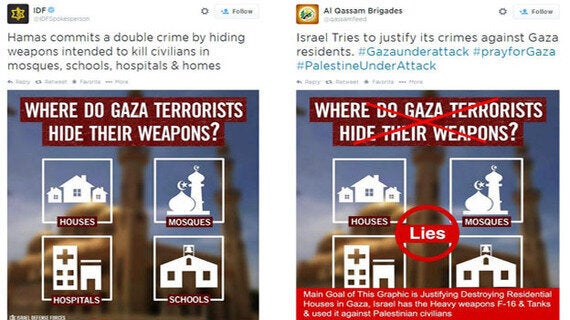If we saw Iraq through our TV screens, then we're seeing Gaza through our newsfeeds. Just as the Gulf War was known by media commentators as the "CNN war", due to the power of their live updates on Desert Storm, the ongoing conflict in Gaza looks set to be remembered as the first ever social media war. How has this come about and what will be the impact for governments, soldiers and civilians?
War has traditionally been the most challenging of all journalistic assignments. Journalists were often frustrated by military restrictions and were forced to remain part of the dreaded 'pool' system or become embedded reporters, where their access and content was at the mercy of military censors.
During the Gulf War, the military pool was based in Saudi Arabia, meaning reporters were reliant on US-supplied footage of bombing raids, which gave a false perception of the accuracy of the raids.
These restrictions meant that the true civilian impact of aerial bombing was rarely broadcast during the Gulf War or indeed during other 'broadcast wars'. This has dramatically changed in the social media age, now those at the centre of warfare can now produce, upload and share their own content.
Instant Twitter reporting circumvents any potential filters or editors, whether through government censorship or the policies of media outlets. This is markedly different from the 2009 Gaza conflict, when limited access to bombing areas meant that reporting was significantly more patchy and inconsistent.
The social media support for the Palestinians has been bolstered by these images, with pictures of children killed by the bombings of Gaza beach and Jabalya Girls Elementary School being quickly shared to large audiences across Twitter.
These images are considerably more graphic and distressing than would be published in print or on TV, meaning Netanyahu's comment that Hamas were exploiting "telegenically dead" Gaza residents aroused considerable outrage on social media.
This gulf between print and social news priorities was exemplified the day after the school bombing, where only one UK newspaper led with the story on their front page. The image of this front cover soon became one of the most retweeted newspaper front covers in Twitter history.
Tales of civilian life in Gaza have been brought to the forefront of the media narrative, with Gaza residents able to describe conditions in the Strip, leading to the often uncomfortable spectacle of them live tweeting their own bombing. 16-year-old Farah Baker has amassed 93,000 followers, due to her emotional and compelling updates, including "This is in my area. I can't stop crying. I might die tonight" during a particularly intense raid.
Governments have also moved quickly to join the social media revolution. The IDF's official Twitter account is a smartly equipped and resourced page, which aims to give the Israeli perspective on the conflict through a series of posts, graphics and videos. The Israeli Ambassador to the USA, Ron Dermer, took place in a live Twitter webchat to explain Israeli policy, which drew 27,000 responses (mostly critical). The variety and quality of the content shows a considerable investment by Israel in its social media activity, as it arguably overtakes print and broadcast media in importance.
It is clear that social media is now an indispensable part of the toolkit for anyone involved in modern conflict, but it also seems likely that its impact will help shape military tactics and decision making in the future.
Political commentators occasionally refer to the 'CNN effect', where emotive TV pictures encourage governments to both enter and exit wars and humanitarian disasters. Footage of dead American soldiers being dragged through the streets of Mogadishu on rolling news channels forced an immediate withdrawal, which was one of the reasons for American reluctance to intervene during the Rwandan Genocide the following year.
This trend has been accentuated by the arrival of social media, although the spotlight is increasingly now placed on civilian victims of war. Pictures and videos of ISIS atrocities spread quickly on social media, placing pressure on the US government to intervene militarily.
Whereas governments have traditionally preferred to use aerial bombing over ground offensives due to the smaller number of 'home casualties', militaries may have to rethink their strategies to allow greater discrimination between civilian and non-civilian combatants.
Governments and non-state actors will continue to invest in social media, both in and out of wartime, with the Gaza conflict providing clear examples of its value. The "war room" in Hasbara, Israel, doesn't control tanks but tweets. Four hundred students, speaking 30 languages, sit at banks of computers to promote the reputation of Israel online. The Hamas Interior Ministry has also published social media guidance for its supporters, instructing them how to make their posts impactful and shareable.

Hamas using Twitter to respond to an IDF graphic, also posted via Twitter
The rise of social media has transformed the way that warfare is viewed, reported and conducted. Civilians and armed forces now realise that Twitter is a true weapon of war, which can shape a conflict just like a bomb or bullet.